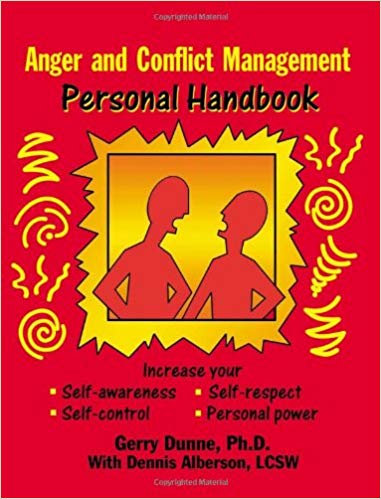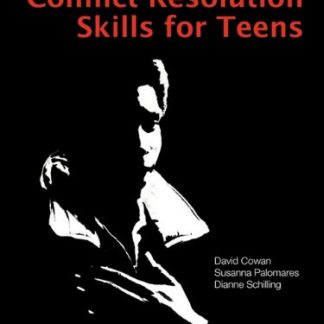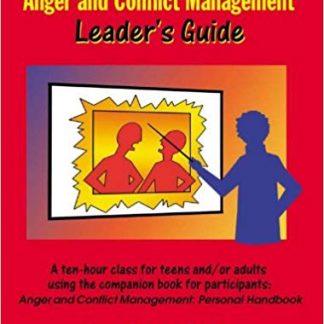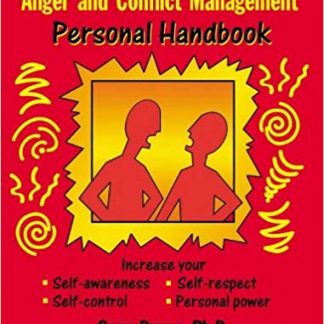Anger and Conflict Management: Personal Handbook
$19.95
Gerry Dunne, Ph.D.
This is the personal component of the Anger and Conflict Managment Program. It is specifically designed to have leader facilitation to guide participants through its content and to provide accountability. The handbook “talks to readers” offering ideas, information and space for reactions while learning lots of strategies — intelligent things to say and do when a conflict occurs or is about to occur. It helps users learn to be assertive and channel anger into productive responses; learn to respect self and others; learn effective interpersonal skills and self-control. The overall goals are better relationships and positive personal power!
The personal handbook is a guided journal with information, ideas, short stories, and questions for students to answer in writing, enabling them to examine their personal responses to life’s typical anger-provoking situations at home, work, school, and elsewhere.
Table of Contents
Guiding Principles for the Class
“Emotions are the Prime Movers…” an Introduction
Anger: Feel It and Channel It: Overview of Key Concepts
Chapter One: How Does Your Own Anger Affect You?
- Anger happens!
- What happens to your brain and body when you get mad?
- Understanding the Differences between Appropriate and Inappropriate Anger
- Past Hurts Come Back!
- Gunnysacking
- Acting on Habit
- Having Unrealistic Expectations
- Homework and Life Work
“Have You Heard the One about the Puzzled New Husband?” a Short Story
Chapter Two: Anger and Family Dynamics
- Anger Is a Natural Emotion
- When Anger Happens in Families
- Unconscious Imitation
- Acting Out
- Displacement
- Scapegoating
- Rivalries
- Ideas for Stopping, and Re-Channelling, Destructive Behavior at Home
- What if someone else in your family is being irrational and destructive?
- What does it take to use your anger constructively?
- Homework and Life Work
Adelita, a Short Story
Chapter Three: Anger and Interpersonal Communication
- Why be concerned about interpersonal communication skills?
- Your Body Speaks Your Truth
- What about Your Spoken Language?
- Good Communicators are Good Listeners!
- The Communication Stoppers!
- The Highest Level of Listening
- Homework and Life Work
“Life Lessons…” a Short Story
Chapter Four: Anger and Conflict Management Strategies
- The Aggressive Style
- The Submissive Style
- The Assertive Style
- How assertive are you?
- Conflict Happens!
- “I Messages”
- Active Listening
- Compromising
- Postponing
- Apologizing and/or Expressing Regret
- Problem Solving
- Homework and Life Work
“I Never Met a Man I Didn’t Like…” a Short Story
Chapter Five: More Anger and Conflict Management Strategies
- When the going really gets tough—what should you do?
- Arm Yourself Mentally
- Chill Yourself Out
- Consider the Consequences
- How to Respond to Verbal Assault
- How to Respond to Extreme Hostility
- How to Respond to a Bully
- How to Respond to Peer Pressure
- Resolve Problems with Mediation
- Homework and Life Work
Resources
Teens/Adults, 96 pages, 8-1/2 x 11, paperback
Description
Gerry Dunne, Ph.D.
This is the personal component of the Anger and Conflict Managment Program. It is specifically designed to have leader facilitation to guide participants through its content and to provide accountability. The handbook “talks to readers” offering ideas, information and space for reactions while learning lots of strategies — intelligent things to say and do when a conflict occurs or is about to occur. It helps users learn to be assertive and channel anger into productive responses; learn to respect self and others; learn effective interpersonal skills and self-control. The overall goals are better relationships and positive personal power!
The personal handbook is a guided journal with information, ideas, short stories, and questions for students to answer in writing, enabling them to examine their personal responses to life’s typical anger-provoking situations at home, work, school, and elsewhere.
Table of Contents
Guiding Principles for the Class
“Emotions are the Prime Movers…” an Introduction
Anger: Feel It and Channel It: Overview of Key Concepts
Chapter One: How Does Your Own Anger Affect You?
- Anger happens!
- What happens to your brain and body when you get mad?
- Understanding the Differences between Appropriate and Inappropriate Anger
- Past Hurts Come Back!
- Gunnysacking
- Acting on Habit
- Having Unrealistic Expectations
- Homework and Life Work
“Have You Heard the One about the Puzzled New Husband?” a Short Story
Chapter Two: Anger and Family Dynamics
- Anger Is a Natural Emotion
- When Anger Happens in Families
- Unconscious Imitation
- Acting Out
- Displacement
- Scapegoating
- Rivalries
- Ideas for Stopping, and Re-Channelling, Destructive Behavior at Home
- What if someone else in your family is being irrational and destructive?
- What does it take to use your anger constructively?
- Homework and Life Work
Adelita, a Short Story
Chapter Three: Anger and Interpersonal Communication
- Why be concerned about interpersonal communication skills?
- Your Body Speaks Your Truth
- What about Your Spoken Language?
- Good Communicators are Good Listeners!
- The Communication Stoppers!
- The Highest Level of Listening
- Homework and Life Work
“Life Lessons…” a Short Story
Chapter Four: Anger and Conflict Management Strategies
- The Aggressive Style
- The Submissive Style
- The Assertive Style
- How assertive are you?
- Conflict Happens!
- “I Messages”
- Active Listening
- Compromising
- Postponing
- Apologizing and/or Expressing Regret
- Problem Solving
- Homework and Life Work
“I Never Met a Man I Didn’t Like…” a Short Story
Chapter Five: More Anger and Conflict Management Strategies
- When the going really gets tough—what should you do?
- Arm Yourself Mentally
- Chill Yourself Out
- Consider the Consequences
- How to Respond to Verbal Assault
- How to Respond to Extreme Hostility
- How to Respond to a Bully
- How to Respond to Peer Pressure
- Resolve Problems with Mediation
- Homework and Life Work
Resources
Teens/Adults, 96 pages, 8-1/2 x 11, paperback





Reviews
There are no reviews yet.